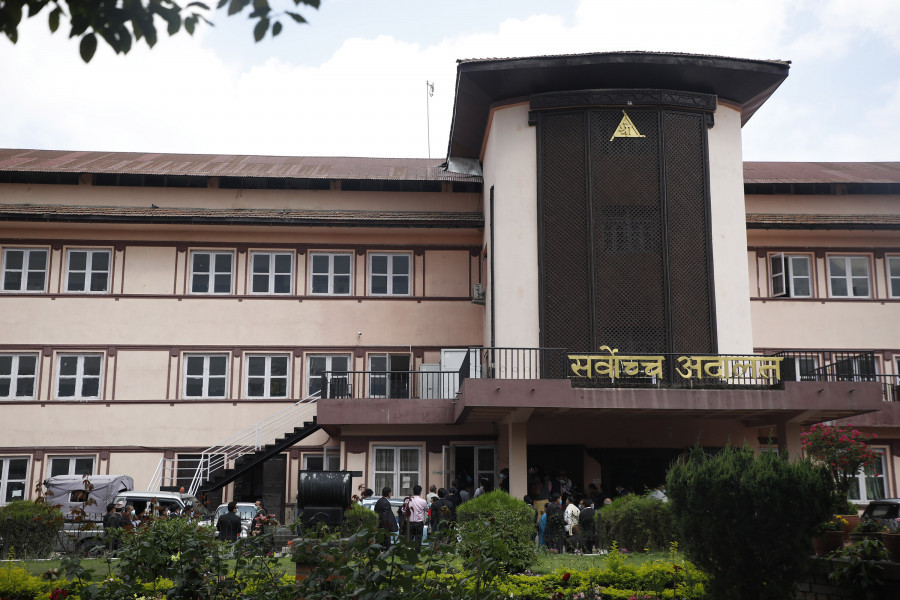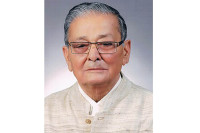National
Constitutional Bench puts to bed questions over its composition
After hearing opening arguments, justices ask defendants in House dissolution cases to furnish clarification by June 23. The bench also seeks amicus curiae briefs.
Binod Ghimire
The Supreme Court on Wednesday asked the Office of the President, Prime Minister’s Office, the federal parliament and Prime Minister KP Sharma Oli to present in writing the reasons behind dissolving the House of Representatives.
They have been given seven days.
The Constitutional Bench headed by Chief Justice Cholendra Shumsher Rana directed the defendants to present the reasons why the court should not issue a verdict as demanded by the petitioners, who have claimed the House dissolution is unconstitutional and that Nepali Congress President Sher Bahadur Deuba should have been appointed prime minister.
The defendants have been asked to furnish their clarification through the Office of the Attorney General within the stipulated time.
The bench has also said it won’t accept any excuse for not presenting the clarification by the set deadline.
The court has also sought original copies of the Cabinet recommendation to the President to dissolve the House and the decision of the Office of the President on House dissolution. The deadline is—seven days starting Wednesday.
In a midnight political drama, Prime Minister KP Sharma Oli on May 21 recommended the dissolution of the House of Representatives, for the second time in a span of six months. Accordingly, President Bidya Devi Bhandari at 1:49am on May 22 dissolved the House and called snap polls for November 12 and 19.
The Constitutional Bench’s orders on Wednesday came after weeklong arguments and counterarguments over its composition.
As many as 30 petitions, one including the opposition alliance led by Congress President Deuba, have been filed against the May 22 House dissolution.
Though Chief Justice Rana had constituted the bench to hear the cases on May 28, it had failed to enter into the core issues, after questions were asked about the presence of Justices Tej Bahadur KC and Bam Kumar Shrestha on the bench.
Chief Justice Rana then on Sunday reconstituted the bench incorporating justices on the basis of their seniority. But those defending Oli, including Attorney General Ramesh Badal, questioned the presence of Justices Deepak Kumar Karki and Ananda Mohan Bhattarai, thereby delaying the hearing.
On Wednesday, the bench, however, took a strong position and refused to entertain any further arguments on its composition.
The Constitutional Bench this time appears set to pass a verdict at the earliest.
“The issues raised by the petitioners are of grave public concern and require to be sorted out without delay,” reads the order. “Continuous hearing would start from June 23.”
The bench has also sought amici curiae briefs from two senior advocates each from the Nepal Bar Association and the Supreme Court Bar Association.
In an attempt to shorten the hearing process, the bench has adopted a strategy to shorten the hearing period by not allowing unlimited time to advocates to make their arguments. It has decided to allow 15 hours maximum to present arguments–to both sides. Similarly, each amicus will get 30 minutes to present their arguments before the bench.
Experts on constitutional matters say unlike the last time, the court appears to have attempted to take steps to systematise and streamline the hearing process.
“The court has allocated adequate time,” senior advocate Purna Man Shakya, also a professor at Nepal Law Campus, told the Post. “Its effort to systematise the hearing process is commendable.”
Shakya, who also leads the Supreme Court Bar Association, on June 1 had suggested that Chief Justice Rana constitute the Constitutional Bench with justices based on their seniority.
After questions were raised over the bench composition, which directly meant casting doubts on justices, the judiciary had plunged into a crisis. Chief Justice Rana was under pressure, as responsibility was on him to save the image of the judiciary.
When the plan to amend the Supreme Court (Operation of Constitutional Bench) Regulations was rejected by the full court, calls were growing that Chief Justice Rana should make a strong move and stick to a bench that he reconstituted with the senior justices.
That questions over the composition of the bench had taken a toll on justices was evident from what one of the members said on Wednesday before the hearing.
“The bench will not entertain any questions on the issue of its composition anymore,” said Justice Ishwar Khatiwada. He said that they [the justices] had taken cognizance of all the questions raised over the composition of the Constitutional Bench formed to conduct the hearing on the cases against the dissolution of the House.
“But they won’t provide answers [to those questions] verbally, as silence itself is an answer on some occasions,” said Khatiwada. “We know how to or not to address the concerns raised here.”
Khatiwada added that the issue of bench composition was raised unnecessarily “The last 12 days are forgettable for all of us,” he said.
After Chief Justice Rana reconstituted the bench on Sunday, there are Justices Deepak Kumar Karki, Mira Khadka, Ishwar Khatiwada and Ananda Mohan Bhattarai as members.
Officials at the Supreme Court say that Wednesday’s orders are indicative of a verdict very soon—most probably within a week after the hearing begins on June 23.
The directive to lawyers and the amici curiae to present their legal briefs by June 24, a day after the continuous hearing begins, indicates the court’s intention to pass the verdict without delay, they say.
The orders on Wednesday came after hearing opening arguments from advocates pleading on behalf of the opposition alliance.
“The directives were issued with regards to the petition filed by the 146 lawmakers from the dissolved House of Representatives,” Kishor Paudel, a communication expert at the Supreme Court, told the Post. “The hearing on other 29 petitions filed as public interest litigation will begin after settling the petition filed by the opposition alliance.”
The petition by the opposition alliance, led by Deuba, is also backed by 23 members from the Madhav Nepal faction of the CPN-UML. The opposition alliance, which has demanded restoration of the House, has claimed that Deuba should have been appointed prime minister on May 21 when he went to the President with the signatures of 149 lawmakers.
However, Oli, who was appointed prime minister on May 13 after losing a vote of confidence just three days prior, had also laid claim to the government before the President, saying he had the backing of 153 lawmakers.
Oli’s House dissolution recommendation on May 21 followed President Bhandari’s notice that both Oli and Deuba’s claims were insufficient.
Constitutional experts say Oli had made an illegitimate claim, as he was not allowed to do so without resigning or without going for a floor test. Oli was reappointed prime minister even after losing the May 10 vote of confidence after the opposition alliance could not prove a majority. Experts say after being reappointed on May 13 under Article 76 (3), Oli needed to go through the constitutionally mandated process of securing a vote of confidence instead of recommending invocation of Article 76 (5).
On Wednesday, senior advocates Mahadev Yadav and Shambhu Thapa, arguing on behalf of the opposition alliance, said the lower house was dissolved even though Deuba’s claim for the prime minister was very much valid.
Yadav said that the President didn’t have any constitutional authority to reject the claim by Deuba, who had presented the signatures of 149 lawmakers.
“It's not that there was no prospect of government formation. Actually the President intentionally didn’t want a government to be formed,” said Yadav.
He said the Constitution of Nepal provides four conditions for the formation of the government. The decision of parties comes into play while forming the government under Article 76 (1), 76 (2) and 76 (3).
“But when it comes to Article 76 (5), individual lawmakers are free to make their choice,” argued Yadav.
Yadav also said that Oli’s claim for the prime ministerial post as per Article 76 (5) was unconstitutional because he hadn’t vacated the position while presenting the claim.
Presenting his argument, Thapa said that it is the House of Representatives that decides whether someone has a majority, not the President.
“She must have left it to the lower house to examine who commanded the majority,” said Thapa. “The House was dissolved without letting it form the government as per Article 76 (5), [which is] against the spirit of the constitution.”
He also demanded an interim order to declare Deuba prime minister. However, the bench rejected it saying all the issues would be addressed by the final verdict.
Experts say when the bench will deliver the verdict is just a matter of speculation but what has become apparent is the judiciary seems to be coming back on track and is making attempts to steer clear of any controversy that could tarnish its image.
The confusion over the institution of the Constitutional Bench also seems to have been sorted now, as the current structure sets a precedent that the chief justice should pick justices on the basis of seniority.
“The court’s position on the composition of the bench should have come earlier,” said Shakya. “But better late than never.”




 14.12°C Kathmandu
14.12°C Kathmandu














